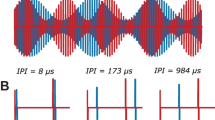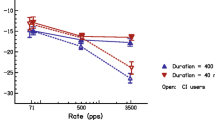Abstract
Electrically evoked auditory steady-state responses (EASSRs) are EEG potentials in response to periodic electrical stimuli presented through a cochlear implant. For low-rate pulse trains in the 40-Hz range, electrophysiological thresholds derived from response amplitude growth functions correlate well with behavioral T levels at these rates. The aims of this study were: (1) to improve the correlation between electrophysiological thresholds and behavioral T levels at 900 pps by using amplitude-modulated (AM) and pulse-width-modulated (PWM) high-rate pulse trains, (2) to develop and evaluate the performance of a new statistical method for response detection which is robust in the presence of stimulus artifacts, and (3) to assess the ability of this statistical method to determine reliable electrophysiological thresholds without any stimulus artifact removal. For six users of a Nucleus cochlear implant and a total of 12 stimulation electrode pairs, EASSRs to symmetric biphasic bipolar pulse trains were recorded with seven scalp electrodes. Responses to six different stimuli were analyzed: two low-rate pulse trains with pulse rates in the 40-Hz range as well as two AM and two PWM high-rate pulse trains with a carrier rate of 900 pps and modulation frequencies in the 40-Hz range. Responses were measured at eight different stimulus intensities for each stimulus and stimulation electrode pair. Artifacts due to the electrical stimulation were removed from the recordings. To determine the presence of a neural response, a new statistical method based on a two-sample Hotelling T 2 test was used. Measurements from different recording electrodes and adjacent stimulus intensities were combined to increase statistical power. The results show that EASSRs to modulated high-rate pulse trains account for some of the temporal effects at 900 pps and result in improved electrophysiological thresholds that correlate very well with behavioral T levels at 900 pps. The proposed statistical method for response detection based on a two-sample Hotelling T 2 test has comparable performance to previously used one-sample tests and does not require stimulus artifacts to be removed from the EEG signal for the determination of reliable electrophysiological thresholds.









Similar content being viewed by others
References
Alaerts J, Luts H, Van Dun B, Desloovere C, Wouters J (2010) Latencies of auditory steady-state responses recorded in early infancy. Audiol Neuro Otol 15(2):116–27
Bohórquez J, Özdamar O (2008) Generation of the 40-Hz auditory steady-state response (ASSR) explained using convolution. Clin Neurophysiol: J Int Fed Clin Neurophysiol 119(11):2598–607
Cafarelli Dees D, Dillier N, Lai WK, von Wallenberg E, van Dijk B, Akdas F, Aksit M, Batman C, Beynon A, Burdo S, Chanal J-M, Collet L, Conway M, Coudert C, Craddock L, Cullington H, Deggouj N, Fraysse B, Grabel S, Kiefer J, Kiss JG, Lenarz T, Mair A, Maune S, Müller-Deile J, Piron J-P, Razza S, Tasche C, Thai-Van H, Toth F, Truy E, Uziel A, Smoorenburg GF (2005) Normative findings of electrically evoked compound action potential measurements using the neural response telemetry of the Nnucleus CI24M cochlear implant system. Audiol Neuro Otol 10(2):105–16
Cebulla M, Stürzebecher E, Elberling C (2006) Objective detection of auditory steady-state responses: comparison of one-sample and q-sample tests. J Am Acad Audiol 17(2):93–103
Cohen LT, Rickards FW, Clark GM (1991) A comparison of steady-state evoked potentials to modulated tones in awake and sleeping humans. J Acoust Soc Am 90(5):2467–79
Davids T, Valero J, Papsin BC, Harrison RV, Gordon KA (2008) Effects of stimulus manipulation on electrophysiological responses of pediatric cochlear implant users. Part II: rate effects. Hear Res 244(1–2):15–24
Dimitrijevic A, John MS, van Roon P, Picton TW (2001) Human auditory steady-state responses to tones independently modulated in both frequency and amplitude. Ear Hear 22(2):100–11
Dobie RA, Wilson MJ (1996) A comparison of t test, F test, and coherence methods of detecting steady-state auditory-evoked potentials, distortion-product otoacoustic emissions, or other sinusoids. J Acoust Soc Am 100(4 Pt 1):2236–46
Galambos R, Makeig S, Talmachoff PJ (1981) A 40-Hz auditory potential recorded from the human scalp. Proc Natl Acad Sci U S A 78(4):2643–7
Galvin JJ, Fu Q-J (2009) Influence of stimulation rate and loudness growth on modulation detection and intensity discrimination in cochlear implant users. Hear Res 250(1–2):46–54
Hall JW (1979) Auditory brainstem frequency following responses to waveform envelope periodicity. Science (New York, NY) 205(4412):1297–9
Hofmann M, Wouters J (2010) Electrically evoked auditory steady state responses in cochlear implant users. JARO 11(2):267–82
Jeng F-C, Abbas PJ, Brown CJ, Miller CA, Nourski KV, Robinson BK (2007) Electrically evoked auditory steady-state responses in Guinea pigs. Audiol Neuro Otol 12(2):101–12
Jeng F-C, Abbas PJ, Brown CJ, Miller CA, Nourski KV, Robinson BK (2008) Electrically evoked auditory steady-state responses in a guinea pig model: latency estimates and effects of stimulus parameters. Audiol Neuro Otol 13(3):161–71
John MS, Picton TW (2000) Human auditory steady-state responses to amplitude-modulated tones: phase and latency measurements. Hear Res 141(1–2):57–79
Kavanagh KT, Domico WD (1986) High-pass digital filtration of the 40 Hz response and its relationship to the spectral content of the middle latency and 40 Hz responses. Ear Hear 7(2):93–9
P R (2011) Kileny. Estimating cochlear implant current level requirements with the electric middle latency responses. 10th European Symposium on Paediatric Cochlear Implantation, May 12-15, Athens, Greece
Kileny PR, Kemink JL (1987) Electrically evoked middle-latency auditory potentials in cochlear implant candidates. Arch Otolaryngol–Head Neck Surg 113(10):1072–7
Kileny PR, Shea SL (1986) Middle-latency and 40-Hz auditory evoked responses in normal-hearing subjects: click and 500-Hz thresholds. J Speech Hear Res 29(1):20–8
Luts H, Desloovere C, Wouters J (2006) Clinical application of dichotic multiple-stimulus auditory steadystate responses in high-risk newborns and young children. Audiol Neuro Otol 11(1):24–37
Miller CA, Hu N, Zhang F, Robinson BK, Abbas PJ (2008) Changes across time in the temporal responses of auditory nerve fibers stimulated by electric pulse trains. JARO 9(1):122–37
T W Picton (2010) Human auditory evoked potentials. San Diego, Plural Publishing, Inc. ISBN 1597563625
Picton TW, Skinner CR, Champagne SC, Kellett AJC, Maiste AC (1987) Potentials evoked by the sinusoidal modulation of the amplitude or frequency of a tone. J Acoust Soc Am 82(1):165–78
Picton TW, John MS, Dimitrijevic A, Purcell DW (2003) Human auditory steady-state responses. Int J Audiol 42(4):177–219
Purcell DW, John MS, Schneider BA, Picton TW (2004) Human temporal auditory acuity as assessed by envelope following responses. J Acoust Soc Am 116(6):3581
Rance G, Rickards F (2002) Prediction of hearing threshold in infants using auditory steady-state evoked potentials. J Am Acad Audiol 13(5):236–45
Rance G, Rickards FW, Cohen LT, De Vidi S, Clark GM (1995) The automated prediction of hearing thresholds in sleeping subjects using auditory steady-state evoked potentials. Ear Hear 16(5):499–507
Stapells DR, Linden RD, Suffield JB, Hamel G, Picton TW (1984) Human auditory steady state potentials. Ear Hear 5(2):105–13
Stapells DR, Makeig S, Galambos R (1987) Auditory steady-state responses: threshold prediction using phase coherence. Electroencephalogr Clin Neurophysiol 67(3):260–70
Stürzebecher E, Cebulla M, Wernecke K (1999) Objective response detection in the frequency domain: comparison of several q-sample tests. Audiol Neuro Otol 4(1):2–11
Suzuki T, Kobayashi K, Hirabayashi M (1983) Frequency composition of auditory middle responses. Br J Audiol 17(1):1–4
Wichmann FA, Hill NJ (2001a) The psychometric function: I. Fitting, sampling, and goodness of fit. Percept Psychophys 63(8):1293–313
Wichmann FA, Hill NJ (2001b) The psychometric function: II. Bootstrap-based confidence intervals and sampling. Percept Psychophys 63(8):1314–29
Wilson B, Ghassemlooy Z (1993) Pulse time modulation techniques for optical communications: a review. IEE Proc J Optoelectron 140(6):346
Acknowledgements
This research is supported by Cochlear Ltd in the frame of IWT (Institute for the Promotion of Innovation by Science and Technology in Flanders) project 080304 and by the Research Council of the Katholieke Universiteit Leuven in the frame of OT grant OT/07/056. Portions of this research have been presented at the European Symposium on Pediatric Cochlear Implantation (ESPCI), Athens, Greece, 12–15 May 2011, the XXII Biennial Symposium of the International Evoked Response Audiometry Study Group (IERASG), Moscow, Russia, 26–30 June 2011, the Conference on Implantable Auditory Prostheses (CIAP), Asilomar, California, United States, 24–29 July 2011, and the International Symposium on Auditory and Audiological Research (ISAAR), Nyborg, Denmark, 24–26 August 2011.
Author information
Authors and Affiliations
Corresponding author
Appendix
Appendix
A implementation of Hotelling T 2 test
One measurement with complex frequency bins B corresponding to the modulation frequencies was represented by a matrix D defined as
with the number of modulation frequencies K, number of measurements L, number of epochs M, and number of recording electrodes N. Different sample sets with the same modulation frequency were combined into a matrix X with dimensions M × O
and normalized into a matrix \( \mathop{X}\limits^{ \cdot } \) obtained by column-wise division with the standard deviation S
For the Hotelling T 2 test, \( \dot{X} \) was reshaped into a two-column matrix \( \ddot{X} \)
that contained the real components in the first and the imaginary components in the second column. The Hotelling T 2 statistic and the probability of the incorrect rejection of the null hypothesis p was determined from the difference of the means \( \Delta \ddot{X} \) of sample sets for two different frequencies in \( {\ddot{X}_1} \) and \( {\ddot{X}_2} \)
and the pooled covariance matrix \( \ddot{C} \)
with the cumulative density function of the \( {χ^2} \) distribution \( {F_{{{χ^2}}}} \), and correction factor r as
B determination of r by Monte Carlo simulation
The Hotelling T 2 test expects independent samples which is not necessarily true for the EEG recorded from multiple electrodes at the same time. This was mitigated by the calculation of the size of an equivalent sample set of independent samples, represented by the correction factor r which was determined by Monte Carlo simulation.
The dependencies between the recording electrodes were modeled by the covariance matrices for the real and imaginary components C re and C im.
Correlated random matrices \( {\dot{X}_{{R,k}}} \) were calculated from independent normally distributed random data matrices P and Q with dimensions M × O and zero mean by applying the Cholesky decomposition to the covariance matrices
For 10,000 trials with different matrices P and Q, Eqs. 5 to 8 were used to characterize the distribution of \( T^{2}_{R} \) for normally distributed random data with the specified covariance matrices and to determine the cumulative density function \( F_R\left( {T^{2}_{R} } \right) \). Least squares approximation was then used to determine the correction parameter r for the \( {χ^2} \) cumulative density function \( {F_{{{χ^2}}}} \) with two degrees of freedom by
Rights and permissions
About this article
Cite this article
Hofmann, M., Wouters, J. Improved Electrically Evoked Auditory Steady-State Response Thresholds in Humans. JARO 13, 573–589 (2012). https://doi.org/10.1007/s10162-012-0321-8
Received:
Accepted:
Published:
Issue Date:
DOI: https://doi.org/10.1007/s10162-012-0321-8




